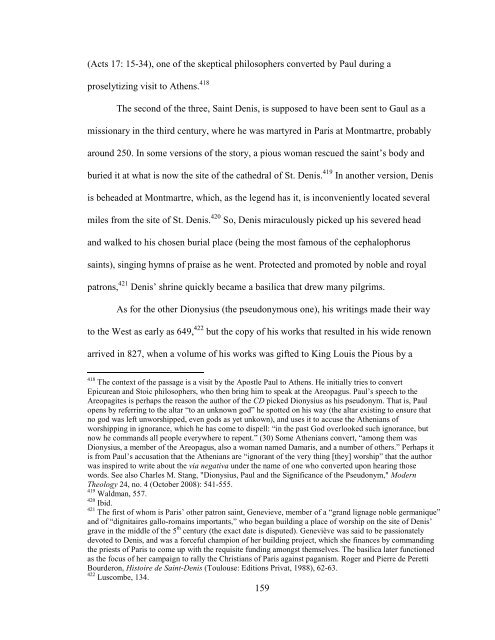the mystical theology of valentin weigel - DataSpace at Princeton ...
the mystical theology of valentin weigel - DataSpace at Princeton ...
the mystical theology of valentin weigel - DataSpace at Princeton ...
Create successful ePaper yourself
Turn your PDF publications into a flip-book with our unique Google optimized e-Paper software.
(Acts 17: 15-34), one <strong>of</strong> <strong>the</strong> skeptical philosophers converted by Paul during a<br />
proselytizing visit to A<strong>the</strong>ns. 418<br />
The second <strong>of</strong> <strong>the</strong> three, Saint Denis, is supposed to have been sent to Gaul as a<br />
missionary in <strong>the</strong> third century, where he was martyred in Paris <strong>at</strong> Montmartre, probably<br />
around 250. In some versions <strong>of</strong> <strong>the</strong> story, a pious woman rescued <strong>the</strong> saint’s body and<br />
buried it <strong>at</strong> wh<strong>at</strong> is now <strong>the</strong> site <strong>of</strong> <strong>the</strong> ca<strong>the</strong>dral <strong>of</strong> St. Denis. 419 In ano<strong>the</strong>r version, Denis<br />
is beheaded <strong>at</strong> Montmartre, which, as <strong>the</strong> legend has it, is inconveniently loc<strong>at</strong>ed several<br />
miles from <strong>the</strong> site <strong>of</strong> St. Denis. 420 So, Denis miraculously picked up his severed head<br />
and walked to his chosen burial place (being <strong>the</strong> most famous <strong>of</strong> <strong>the</strong> cephalophorus<br />
saints), singing hymns <strong>of</strong> praise as he went. Protected and promoted by noble and royal<br />
p<strong>at</strong>rons, 421 Denis’ shrine quickly became a basilica th<strong>at</strong> drew many pilgrims.<br />
As for <strong>the</strong> o<strong>the</strong>r Dionysius (<strong>the</strong> pseudonymous one), his writings made <strong>the</strong>ir way<br />
to <strong>the</strong> West as early as 649, 422 but <strong>the</strong> copy <strong>of</strong> his works th<strong>at</strong> resulted in his wide renown<br />
arrived in 827, when a volume <strong>of</strong> his works was gifted to King Louis <strong>the</strong> Pious by a<br />
418 The context <strong>of</strong> <strong>the</strong> passage is a visit by <strong>the</strong> Apostle Paul to A<strong>the</strong>ns. He initially tries to convert<br />
Epicurean and Stoic philosophers, who <strong>the</strong>n bring him to speak <strong>at</strong> <strong>the</strong> Areopagus. Paul’s speech to <strong>the</strong><br />
Areopagites is perhaps <strong>the</strong> reason <strong>the</strong> author <strong>of</strong> <strong>the</strong> CD picked Dionysius as his pseudonym. Th<strong>at</strong> is, Paul<br />
opens by referring to <strong>the</strong> altar “to an unknown god” he spotted on his way (<strong>the</strong> altar existing to ensure th<strong>at</strong><br />
no god was left unworshipped, even gods as yet unkown), and uses it to accuse <strong>the</strong> A<strong>the</strong>nians <strong>of</strong><br />
worshipping in ignorance, which he has come to dispell: “in <strong>the</strong> past God overlooked such ignorance, but<br />
now he commands all people everywhere to repent.” (30) Some A<strong>the</strong>nians convert, “among <strong>the</strong>m was<br />
Dionysius, a member <strong>of</strong> <strong>the</strong> Areopagus, also a woman named Damaris, and a number <strong>of</strong> o<strong>the</strong>rs.” Perhaps it<br />
is from Paul’s accus<strong>at</strong>ion th<strong>at</strong> <strong>the</strong> A<strong>the</strong>nians are “ignorant <strong>of</strong> <strong>the</strong> very thing [<strong>the</strong>y] worship” th<strong>at</strong> <strong>the</strong> author<br />
was inspired to write about <strong>the</strong> via neg<strong>at</strong>iva under <strong>the</strong> name <strong>of</strong> one who converted upon hearing those<br />
words. See also Charles M. Stang, "Dionysius, Paul and <strong>the</strong> Significance <strong>of</strong> <strong>the</strong> Pseudonym," Modern<br />
Theology 24, no. 4 (October 2008): 541-555.<br />
419 Waldman, 557.<br />
420 Ibid.<br />
421 The first <strong>of</strong> whom is Paris’ o<strong>the</strong>r p<strong>at</strong>ron saint, Genevieve, member <strong>of</strong> a “grand lignage noble germanique”<br />
and <strong>of</strong> “dignitaires gallo-romains importants,” who began building a place <strong>of</strong> worship on <strong>the</strong> site <strong>of</strong> Denis’<br />
grave in <strong>the</strong> middle <strong>of</strong> <strong>the</strong> 5 th century (<strong>the</strong> exact d<strong>at</strong>e is disputed). Geneviève was said to be passion<strong>at</strong>ely<br />
devoted to Denis, and was a forceful champion <strong>of</strong> her building project, which she finances by commanding<br />
<strong>the</strong> priests <strong>of</strong> Paris to come up with <strong>the</strong> requisite funding amongst <strong>the</strong>mselves. The basilica l<strong>at</strong>er functioned<br />
as <strong>the</strong> focus <strong>of</strong> her campaign to rally <strong>the</strong> Christians <strong>of</strong> Paris against paganism. Roger and Pierre de Peretti<br />
Bourderon, Histoire de Saint-Denis (Toulouse: Editions Priv<strong>at</strong>, 1988), 62-63.<br />
422 Luscombe, 134.<br />
159
















